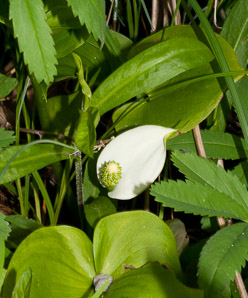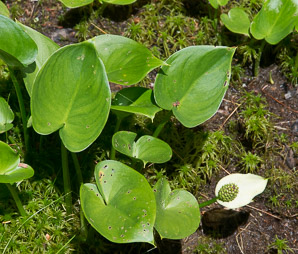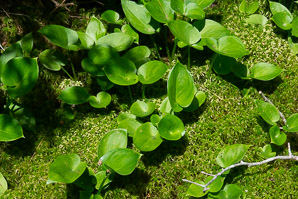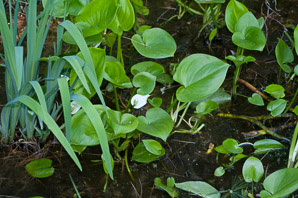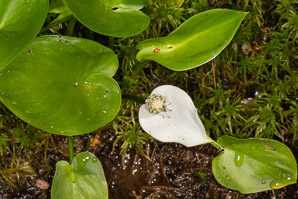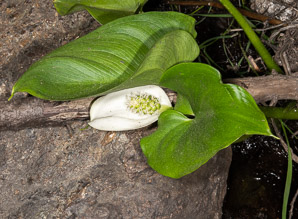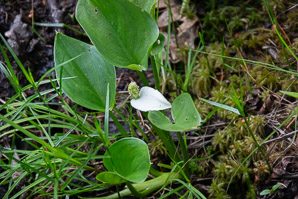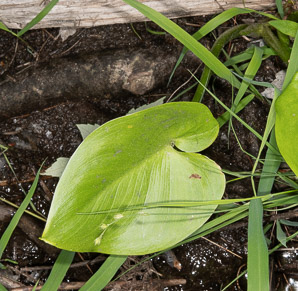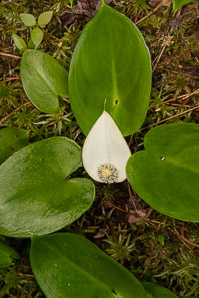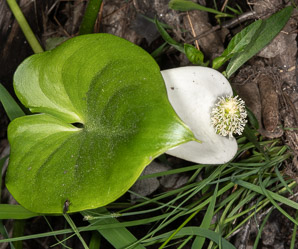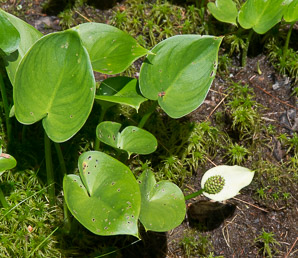
|
Calla palustris L. Wild calla, water arum, wild-calla
These North American native plants inhabit swamps, seasonally flooded bogs, stream banks, ditches, quagmires, and muddy lake shores. Plants: 4-16″ (10-40 cm) in size, partially submerged. They have a weak odor that is unpleasant to people, but that flies and beetles and even snails find appealing. Plants can form thick colonies. Leaves: Leaves emerge on stalks up to 1′ (40 cm), above a submersed rootstalk. Leaves are heart-shaped (ovate), waxy, smooth, and smooth-edged, with edges tending to curl inward. There is a single leaf, 1¾-4½″ (5-12 cm) long, atop each stalk. Flowers: A single white, waxy, heart-shaped “petal,” attached to the stalk at its base, appears to be the flower, but this is really a spathe, a specialized protective leaf. The actual flowerhead, called the spadix, is about 1″ (2.5 cm) long and ½″ (1.3 cm) around, also whitish, and covered with tiny white/green flowers that lack petals. The upper part of the flowerhead has unisexual staminate flowers, while the lower part is bisexual. The flower is supported on a stem 3-12″ (7.6-30 cm) above the water line. They appear from June to July. Fruits: Irregular, angled, but roughly pear-shaped berries up to ½″ (1.3 cm) around, and bright red. Edibility: Poisonous. Online References:
The Central Yukon Species Inventory Project References:
Clemants, Steven; Gracie, Carol, Wildflowers in the Field and Forest, Oxford University Press, 2006, p. 376 5/22/2010 · Garden in the Woods, Framingham, Massachusetts · ≈ 5 × 7″ (12 × 18 cm) 6/19/2021 · Long Reach Preserve, Harpswell, Maine 6/19/2021 · Long Reach Preserve, Harpswell, Maine 5/15/2010 · Garden in the Woods, Framingham, Massachusetts 6/5/2021 · Long Reach Preserve, Harpswell, Maine · ≈ 9 × 6″ (22 × 15 cm)
Calla palustris description by Thomas H. Kent, last updated 24 Aug 2021. © FloraFinder.org. All rights reserved. |
6/3/2018 · Mt. Watatic, Ashby, Massachusetts · ≈ 12 × 8″ (31 × 20 cm) 6/20/2021 · Heath, Cathance River Nature Preserve, Highland Green, Topsham, Maine · ≈ 11 × 7″ (26 × 18 cm) 6/3/2018 · Mt. Watatic, Ashby, Massachusetts · ≈ 8 × 12″ (20 × 31 cm) 6/5/2021 · Long Reach Preserve, Harpswell, Maine · ≈ 6 × 9″ (15 × 22 cm) 6/3/2018 · Mt. Watatic, Ashby, Massachusetts · ≈ 5 × 8″ (13 × 20 cm) 6/3/2018 · Mt. Watatic, Ashby, Massachusetts · ≈ 5 × 8″ (13 × 20 cm) 6/19/2021 · Long Reach Preserve, Harpswell, Maine Range: Zones 2-6:
|
